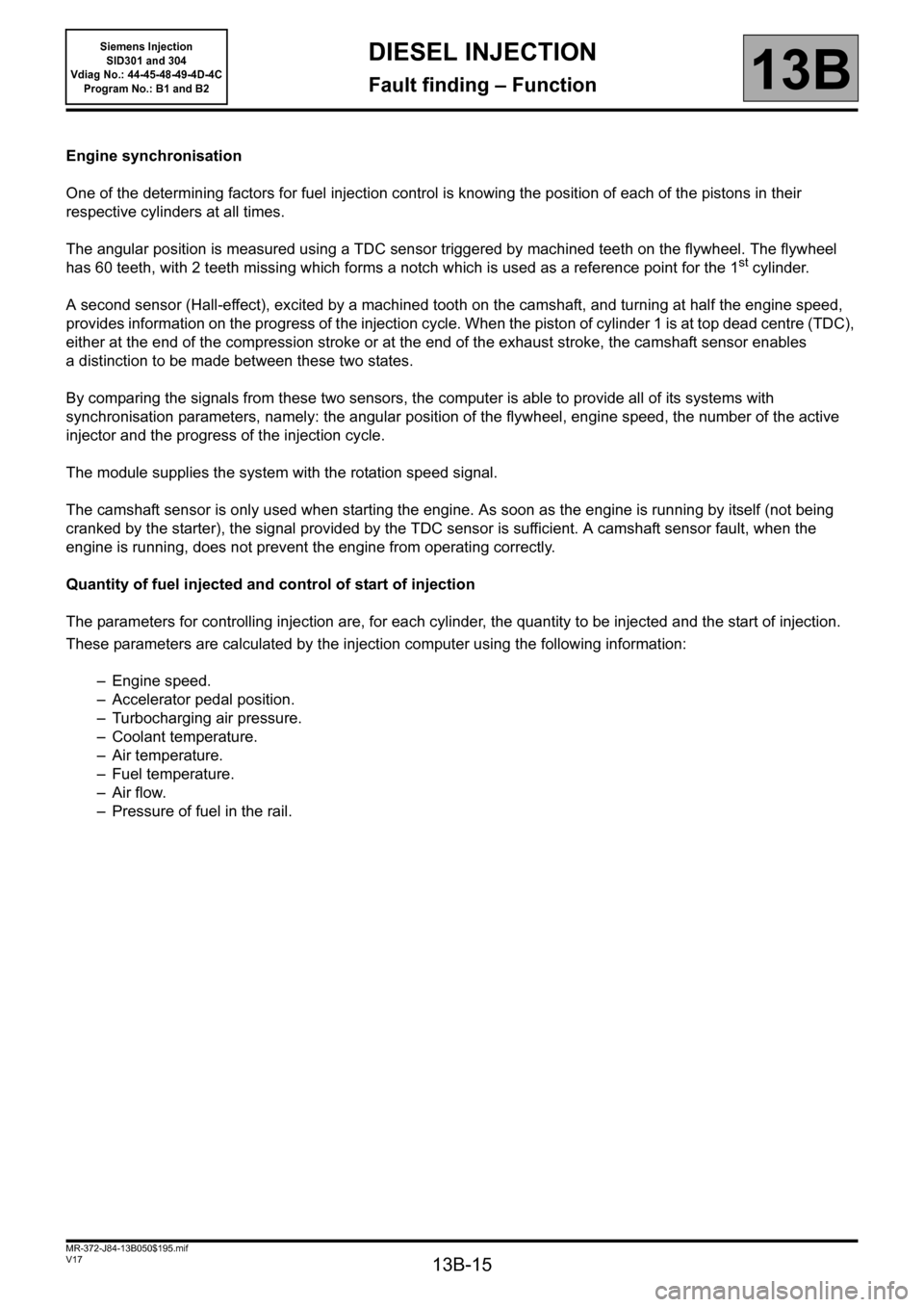turn signal RENAULT SCENIC 2011 J95 / 3.G Engine And Peripherals Siemens Injection Workshop Manual
[x] Cancel search | Manufacturer: RENAULT, Model Year: 2011, Model line: SCENIC, Model: RENAULT SCENIC 2011 J95 / 3.GPages: 329, PDF Size: 1.71 MB
Page 15 of 329

13B-15
MR-372-J84-13B050$195.mif
V17
Siemens Injection
SID301 and 304
Vdiag No.: 44-45-48-49-4D-4C
Program No.: B1 and B2DIESEL INJECTION
Fault finding – Function13B
Engine synchronisation
One of the determining factors for fuel injection control is knowing the position of each of the pistons in their
respective cylinders at all times.
The angular position is measured using a TDC sensor triggered by machined teeth on the flywheel. The flywheel
has 60 teeth, with 2 teeth missing which forms a notch which is used as a reference point for the 1
st cylinder.
A second sensor (Hall-effect), excited by a machined tooth on the camshaft, and turning at half the engine speed,
provides information on the progress of the injection cycle. When the piston of cylinder 1 is at top dead centre (TDC),
either at the end of the compression stroke or at the end of the exhaust stroke, the camshaft sensor enables
a distinction to be made between these two states.
By comparing the signals from these two sensors, the computer is able to provide all of its systems with
synchronisation parameters, namely: the angular position of the flywheel, engine speed, the number of the active
injector and the progress of the injection cycle.
The module supplies the system with the rotation speed signal.
The camshaft sensor is only used when starting the engine. As soon as the engine is running by itself (not being
cranked by the starter), the signal provided by the TDC sensor is sufficient. A camshaft sensor fault, when the
engine is running, does not prevent the engine from operating correctly.
Quantity of fuel injected and control of start of injection
The parameters for controlling injection are, for each cylinder, the quantity to be injected and the start of injection.
These parameters are calculated by the injection computer using the following information:
– Engine speed.
– Accelerator pedal position.
– Turbocharging air pressure.
– Coolant temperature.
– Air temperature.
– Fuel temperature.
–Air flow.
– Pressure of fuel in the rail.
Page 121 of 329

13B-121
MR-372-J84-13B050$468.mif
V17
DIESEL INJECTION
Fault finding – Interpretation of faults
Siemens Injection
SID301 and 304
Vdiag No.: 44-45-48-49-4D-4C
Program No.: B1 and B2
13B
DF1009
PRESENT
OR
STOREDCATALYTIC CONVERTER 1 DOWNSTREAM TEMPERATURE
REGULATION
1. DEF: Signal outside lower limit
2. DEF: Signal outside upper limit
NOTESConditions for applying the fault finding procedure to a stored fault:
The fault becomes present after a road test with particle filter regeneration.
Special notes:
If the fault is present:
The level 1 fault warning light is lit on the instrument panel.
Use CLIO III, MODUS, MEGANE II ph2, SCENIC II ph2 and Kangoo II Wiring
diagrams Technical Note.
Check the connection and condition of the connector of the catalytic converter 1 downstream temperature
sensor, component code 1765.
If the connector is faulty and there is a repair procedure (see Technical Note 6015A, Electrical wiring repair,
Wiring: Precautions for repair), repair the connector, otherwise replace the wiring.
Check the connection and condition of the injection computer connector, component code 120 (see MR 392,
385, 364, 370 and 417, Mechanical, 13B, Diesel injection, Diesel injection computer: Removal - Refitting).
If the connector is faulty and there is a repair procedure (see Technical Note 6015A, Electrical wiring repair,
Wiring: Precautions for repair), repair the connector, otherwise replace the wiring.
With the ignition on, check the continuity, insulation and absence of interference resistance on the following
connections:
–3AGX between components 1765 and 120,
–3AGY between components 1765 and 120.
If the connection(s) are faulty and there is a repair method (see Technical Note 6015A, Repairing electrical
wiring, Wiring: Precautions for repair), repair the wiring, otherwise replace it.
If the fault is still present, replace the turbine upstream temperature sensor.
While the engine is idling, check the return flow rate at the injectors.
After 5minutes the return volume must be between 16 mland 24 ml per injector.
If this tolerance is incorrect, replace the faulty injector(s).
Check the temperature of the catalytic converter; check that it is not too low.
Check that the exhaust system is not pierced.
Replace any faulty components.
AFTER REPAIRDeal with any faults displayed by the diagnostic tool.
Clear the computer fault memory.
Carry out a road test followed by another check with the diagnostic tool.
SID301_V44_DF1009 / SID304_V45_DF1009 / SID301_V48_DF1009 / SID304_V49_DF1009 / SID304_V4D_DF1009 / SID301_V4C_DF1009